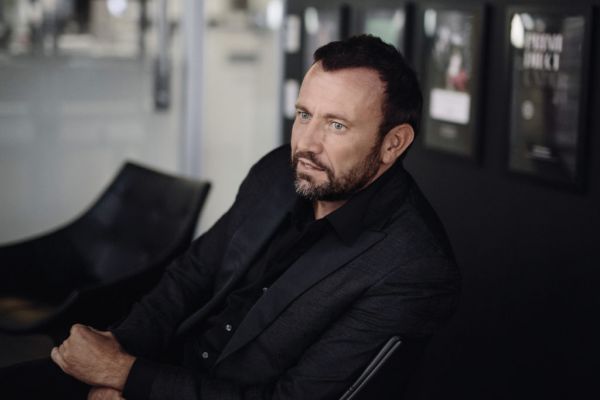Brands need to adopt a ‘human-centred’ way of thinking – with design at its heart – in order to continue to compete in a complex masterpiece, according to Mauro Porcini, PepsiCo’s chief design officer. Steve Wynne-Jones spoke to him. This article is available to Premium and Premium Plus subscribers only.
For someone who lives and breathes design, PepsiCo’s Mauro Porcini admits that the nuances behind the perfect pint of Guinness had him stumped on his first visit to the Irish capital.
“I studied at Dublin’s National College of Art and Design for a year, and on the first night I arrived, I made the worst mistake you can make in an Irish pub,” he says. “I went to the bar and ordered a Guinness, and while it was settling, I picked it up and started drinking it, without waiting for the second pour. That’s a serious error, I know!”
Fast forward 25 years, and Porcini is now regarded one of the most authoritative voices on design in the consumer goods industry, having been appointed chief design officer at PepsiCo eight years ago.
“It’s a position that didn’t exist then, and still doesn’t exist now at many companies,” he says.
In his role, he’s on a mission to evolve how PepsiCo (and the FMCG market in general) thinks about design. As he explains, it’s not just about packaging, it’s about creating experiences for consumers.
ESM caught up with Porcini on the sidelines of the recent ‘Collision from Home’ conference, and found him in optimistic form about the opportunities for the post-COVID consumer.
“I think this crisis forces humanity, for the first time – at least in our lifetime – to realise we’re all on the same side of the fence,” he says.
“We were living in a world where people, governments, businesses were putting financial gain ahead of everything else, or fame, or success, and all of a sudden, this crisis has put that into context.”
For the consumer goods industry, Porcini believes that the current situation offers an opportunity to double down on what he describes as a “human-centred approach”, with design playing a key role in this evolution.
Radical Changes
As Porcini, who spent a decade with 3M before joining the soft-drink giant in 2012, explains, at present, the consumer goods sector is seeing a number of “radical changes” to which brands need to be prepared to respond and react.
“First of all, anybody – any person in the street – can come up with an idea, get access to funding, and get a product to market,” he says. “The idea of a start-up is part of our way of thinking these days. The cost of production is going down and will drop even further in the near future. Also, now you can go straight to consumers through e-commerce and develop a marketing campaign through social media.”
All of these areas – product development, marketing, category management – were previously the preserve of big brands, and big brands alone, but the proliferation of new entrants to the marketplace has altered the dynamic.
“OK, many of these new brands might only last six months or a year, and then disappear,” Porcini says, “but some start to get penetration, and then it becomes less about market share and more about ‘mind’ share. If big brands don’t move or evolve, they run the risk of becoming obsolete.”
The Age Of Excellence
According to Porcini, the consumer goods sector is now entering what he describes as the “Age of Excellence” – “either you create excellence, and you create something extraordinary, or someone else will do it for you” – backed by a fundamental shift in the role of marketing.
“Historically, we have built brands with top-down communication, where marketing takes place in one direction,” he says. “This one-way communication has then shifted from traditional media to new media – a brand will take the same content that they would use in traditional advertising and translate that content into social media, but social media is not a one-way communication platform.
"It works both ways, or – even better – as a dialogue. We’re moving from a world in which we were buying the right to talk to people to a world a brand needs to earn the right to be talked about.”
While conversations about design are generally down the list of a company’s priorities – particularly in businesses built around a quarterly reporting structure – Porcini believes that with the right kind of leadership, it can play an important role in how a business approaches the market. Design shouldn’t be a “project”, he suggests, it should be a cultural journey.
“It’s not just a case of design leadership,” he says. “It’s about the CEO or the executive board having the vision and understanding of where you can take the company and having the courage to do it. I remember that my first conversation with [former PepsiCo CEO] Indra Nooyi eight years ago was not around ‘good’ or ‘bad’ design, it was about evolving the culture of the company.”
To Porcini, design thinking is about connecting three “dimensions” – empathy, strategy and prototyping – as well as seeking out quick-wins from what is generally a long-term approach. As he notes, what started out as a team of 15 at his disposal eight years ago has evolved into a squad of more than 250.
“By empathy, I mean understanding people, their needs, and what they want,” he says. “Strategy is the ability to understand what a company’s culture is, and the right business model and the right processes to use. Once that is achieved, you start to prototype based on this new methodology. I call these ‘proof points’.
“You need to generate proof points very quickly when you create a new culture, because many companies move fast – they operate from quarter to quarter. So, when you are building a long-term vision, you need to identify some quick-wins, as soon as possible. The more value you can unlock, the more resources you can unlock, and the more excitement there is in the organisation.”
Building Trust
This approach can also reap benefits when it comes to rebuilding trust with consumers – something that is in increasingly short supply among the emerging Generation Z cohort, who studies have found to be the most distrusting of brands.
“It’s a negative trend that we’ve been observing for many years now, and it’s accelerating with each new generation, but it was spreading even before that,” Porcini says. “That’s why the idea of human-centric innovation is so important. Behind any big brand or big organisation, there are human beings like you or me, who are creating those brands and creating those products. So, I think storytelling and creating this human-centred approach, that’s the starting point of 99% of everything you need to do.”
Brands should have the confidence to talk about the people behind the product, as well as embrace honesty when it comes to faux pas made along the way, he suggests.
“Through your communication, tell the right stories, and you talk about your vulnerability, about how you strived to ‘get it right’, but made mistakes. In an authentic way, talk about the journey you are on, and how you are trying to get there. People appreciate that honesty.
After all, you can’t have innovation without making some mistakes along the way – and, by the way, you shouldn’t call them mistakes. You should call them ‘experiments’.”
In fact, Porcini also espouses ditching the word ‘consumer’ altogether – thinking of the end user in a more identifiable context.
“‘Consumer’ is a word that I don’t particularly like,” he says. “I prefer to use ‘people’ or ‘human beings’ because the moment you think of them as human beings, you think of them as your mother, or your brother, or your kids, and you want what’s best for them. You care less about selling stuff to them, and more about making them happy.”
The Power Broker
At the same time, while the human-centric process seeks to adopt a more holistic approach to brand development, brands should also be wary of bestowing too much power onto their clientele.
“Something that I think is important to mention – and this is a problem with many companies – is when you move on from being consumer-centric to letting the customer decide the final outcome. By and large, consumers know what happened to them in the past, and in the present, but they don’t know the future.
“There’s that famous quote from Henry Ford, ‘If I had asked people what they wanted, they would have said faster horses.’ You need to have a balance between listening to people and then having the leadership and the vision and the courage to drive change.”
With that in mind, one of Porcini’s long-standing mantras – and one that, by his own admission, he has been using in PowerPoint presentations “for around 20 years” – is ‘Listen to your customers, but don’t believe them.’
“That always gets a few laughs, but it’s true. You need to interpret what they tell you, and try to adapt it, using your intuition and your vision.”
This also applies to how businesses interpret data, he argues.
“This is a time in which everybody talks about data, that maybe data can lead to a world where we don’t need designers any more, and that innovations will suddenly emerge out of that data, but data is, in many cases, the representation of a conversation that once happened between someone who created something and somebody who purchased something. You still need people there to interpret it and create something new. In my mind, you will always need business leaders and innovators to work their magic.”
Or, to put it another way, you can’t rely on data to pour the perfect pint of Guinness.
© 2020 European Supermarket Magazine – your source for the latest retail news. Article by Stephen Wynne-Jones. Click subscribe to sign up to ESM: The European Supermarket Magazine














